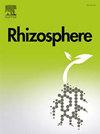Novel approach in soil zymography to assess enzyme activity in the rhizosphere
IF 3.4
3区 生物学
Q1 PLANT SCIENCES
引用次数: 0
Abstract
Soil zymography is increasingly used to study belowground plant-soil interactions and microbial hotspots in the rhizosphere. Over the past decade, several approaches have been proposed to quantitatively estimate enzymatic activity in rhizosphere hotspots using root masks based on normal light (NL) root photos. However, these approaches are often time-consuming and typically applied to small regions of zymograms. Therefore, obtaining automated, but precise root masks for crops with various root system is necessary to improve and standardize soil zymography techniques in rhizosphere studies.
Here we introduced a newly developed approach that involves photographing roots under ultraviolet (UV) light after conducting zymography to create a root mask for six crops: maize, wheat, barley, rye, lupine, and faba bean grown on Loamy Luvisol. Our study revealed a significant improvement in the quality of root masks thresholded from UV light root photos compared to NL photos.
The β-glucosidase activity measured within the root mask thresholded from UV root photos enabled accurate estimation of the root-associated enzyme activity for all six crops. This offers substantial advantages over measuring enzyme activity across the entire zymogram, that often leads to imprecise interpretations of zymography results in the rhizosphere studies. Moreover, UV root photos taken after zymography allow to detect metabolically active and growing roots. Additionally, high contrast of UV root photos and clear delineation of roots on the soil surface for all studied crops enables using these photos for precise alignment of soil images of different origin in the co-localization analysis.

求助全文
约1分钟内获得全文
求助全文
来源期刊

Rhizosphere
Agricultural and Biological Sciences-Agronomy and Crop Science
CiteScore
5.70
自引率
8.10%
发文量
155
审稿时长
29 days
期刊介绍:
Rhizosphere aims to advance the frontier of our understanding of plant-soil interactions. Rhizosphere is a multidisciplinary journal that publishes research on the interactions between plant roots, soil organisms, nutrients, and water. Except carbon fixation by photosynthesis, plants obtain all other elements primarily from soil through roots.
We are beginning to understand how communications at the rhizosphere, with soil organisms and other plant species, affect root exudates and nutrient uptake. This rapidly evolving subject utilizes molecular biology and genomic tools, food web or community structure manipulations, high performance liquid chromatography, isotopic analysis, diverse spectroscopic analytics, tomography and other microscopy, complex statistical and modeling tools.
 求助内容:
求助内容: 应助结果提醒方式:
应助结果提醒方式:


